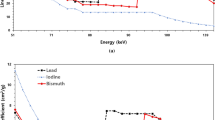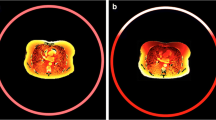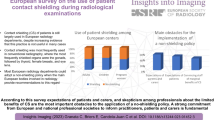Abstract
The study aimed to assess the effect of bismuth (Bi) shielding on dose reduction and image quality in computed tomography (CT) through a literature review. A search was conducted in the following databases: Web of Science, PubMed, Google Scholar, and Scopus. Studies that reported estimated dose reduction with bismuth shielding during imaging of the eye, thyroid, and breast were included, and a meta-regression analysis was used to examine the influence of the CT scanner type on the dose reduction. The studies included a total of 237 patients and 34 pediatric and adult anthropomorphic phantoms for whom the radiation dose was reported. Bismuth shielding was recommended in 88.89% of the studies based on the maintenance of appropriate image quality under shielding. Noise associated with Bi shielding was 7.5%, 263%, and 23.5% for the eye, thyroid, and breast, respectively. The fixed-effects pooled estimate of dose reduction was 34% (95% CI: 13–55; p < 0.001) for the eye, 37% (95% CI 14–61; p < 0.001) for the thyroid, and 36% (95% CI 36–55; p < 0.001) for the breast. The image quality, usage of foams, CT scanner type, beam energies, and backscatter radiation were important factors that directly affected the efficacy of Bi shielding to reduce the radiation dose at the superficial radiosensitive organs.











Similar content being viewed by others
References
Mehnati P, Ghavami M, Heidari H. Reducing radiation doses in female breast and lung during CT examinations of thorax: A new technique in two scanners. J Biomed Phy Eng. 2017;7(3):217.
Mehnati P, Malekzadeh R, Sooteh MY, Refahi S. Assessment of the efficiency of new bismuth composite shields in radiation dose decline to breast during chest CT. Egypt J Radiol Nucl Med. 2018;49(4):1187–9.
Mehnati P, Sooteh MY, Malekzadeh R, Divband B. Synthesis and characterization of nano Bi2O3 for radiology shield. Nanomedicine. 2018;5(4):222–26.
Funama Y, Awai K, Hatemura M, et al. Automatic tube current modulation technique for multidetector CT: is it effective with a 64-detector CT? Radiol Phys Technol. 2008;1(1):33–7.
Morris P, Perkins A. Diagnostic imaging. The Lancet. 2012;379(9825):1525–33.
Mehnati P, Tirtash MJ, Ghavami M. CT role in the assessment of existence of breast cancerous cells. J Biomed Phys Eng. 2016. https://doi.org/10.22086/jbpe.v0i0.384
Muhogora W, Ahmed N, Alsuwaidi J, et al. Paediatric CT examinations in 19 developing countries: frequency and radiation dose. Radiat Prot Dosim. 2010;140(1):49–58.
Broder J, Warshauer DM. Increasing utilization of computed tomography in the adult emergency department, 2000–2005. Emerg radiol. 2006;13(1):25–30.
Broder J, Fordham LA, Warshauer DM. Increasing utilization of computed tomography in the pediatric emergency department, 2000–2006. Emerg radiol. 2007;14(4):227–32.
Smith-Bindman R, Lipson J, Marcus R, et al. Radiation dose associated with common computed tomography examinations and the associated lifetime attributable risk of cancer. Arch Intern Med. 2009;169(22):2078–86.
Saravanakumar A, Vaideki K, Govindarajan K, et al. Assessment of regional pediatric computed tomography dose indices in Tamil Nadu. J Med Phys. 2017;42(1):48.
Kleibl Z, Kristensen VN. Women at high risk of breast cancer: molecular characteristics, clinical presentation and management. The Breast. 2016;28:136–44.
Alizadeh Riabi H, Mehnati P, Mesbahi A. Evaluation of mean glandular dose in a full-field digital mammography unit in Tabriz, Iran. Radiat Prot Dosim. 2010;142(2–4):222–27.
Ferlay J, Steliarova-Foucher E, Lortet-Tieulent J, et al. Cancer incidence and mortality patterns in Europe: estimates for 40 countries in 2012. Eur J cancer. 2013;49(6):1374–403.
DeSantis C, Ma J, Bryan L, et al. Breast cancer statistics, 2013. CA Cancer J Clin. 2014;64(1):52–62.
McCrohan JL, Patterson JF, Gagne R, et al. Average radiation doses in a standard head examination for 250 CT systems. Radiology. 1987;163(1):263–68.
Seidenfuss A, Mayr A, Schmid M, et al. Dose reduction of the female breast in chest CT. AJR Am J Roentgenol. 2014;202(5):W447–W52.
Mehnati P, Amirnia A, Jabbari N. Estimating cancer induction risk from abdominopelvic scanning with 6-and 16-slice computed tomography. IJRB. 2017;93(4):416–25.
Hopper KD, King SH, Lobell M, et al. The breast: in-plane X-ray protection during diagnostic thoracic CT–shielding with bismuth radioprotective garments. Radiology. 1997;205(3):853–58.
Hopper KD ed Orbital, thyroid, and breast superficial radiation shielding for patients undergoing diagnostic CT. Seminars in Ultrasound, CT and MRI; 2002: Elsevier.
Mehnati P, Sooteh MY, Malekzadeh R, Divband B, Refahi S. Breast conservation from radiation damage by using nano bismuth shields in chest CT scan. Crescent J Med Biol Sci. 2018; 5:4.
Spampinato S, Gueli AM, Milone P, et al. Dosimetric changes with computed tomography automatic tube-current modulation techniques. Radiol Phys Technol. 2018;11(2):184–91.
Moher D, Liberati A, Tetzlaff J, et al. Preferred reporting items for systematic reviews and meta-analyses: the PRISMA statement. Ann Intern Med. 2009;151(4):264–69.
Hopper KD, Neuman JD, King SH, et al. Radioprotection to the eye during CT scanning. AJNR Am J Neuroradiol. 2001;22(6):1194–98.
Colombo P, Pedroli G, Nicoloso M, et al. Evaluation of the efficacy of a bismuth shield during CT examinations. Radiol Med (Torino). 2004;108(5–6):560–68.
McLaughlin D, Mooney R. Dose reduction to radiosensitive tissues in CT. Do commercially available shields meet the users’ needs? Clin Radiol. 2004;59(5):446–50.
Mukundan S Jr, Wang PI, Frush DP, et al. MOSFET dosimetry for radiation dose assessment of bismuth shielding of the eye in children. AJR Am J Roentgenol. 2007;188(6):1648–50.
Coursey C, Frush DP, Yoshizumi T, et al. Pediatric chest MDCT using tube current modulation: effect on radiation dose with breast shielding. AJR Am J Roentgenol. 2008;190(1):W54–61.
Lee K, Lee W, Lee J, et al. Dose reduction and image quality assessment in MDCT using AEC (D-DOM & Z-DOM) and in-plane bismuth shielding. Radiat Prot Dosim. 2010;141(2):162–67.
Chang K-H, Lee W, Choo D-M, et al. Dose reduction in CT using bismuth shielding: measurements and Monte Carlo simulations. Radiat Prot Dosim. 2009;138(4):382–88.
Raissaki M, Perisinakis K, Damilakis J, et al. Eye-lens bismuth shielding in paediatric head CT: artefact evaluation and reduction. Pediatr Radiol. 2010;40(11):1748–54.
Gbelcová L, Nikodemova D, Horvathova M. Dose reduction using bismuth shielding during paediatric CT examinations in Slovakia. Radiat Prot Dosim. 2011;147(1–2):160–63.
Wang J, Duan X, Christner JA, et al. Bismuth shielding, organ-based tube current modulation, and global reduction of tube current for dose reduction to the eye at head CT. Radiology. 2012;262(1):191–98.
Huggett J, Mukonoweshuro W, Loader R. A phantom-based evaluation of three commercially available patient organ shields for computed tomography X-ray examinations in diagnostic radiology. Radiat Prot Dosim. 2012;155(2):161–68.
Ciarmatori A, Nocetti L, Mistretta G, et al. Reducing absorbed dose to eye lenses in head CT examinations: the effect of bismuth shielding. Australas Phys Eng Sci Med. 2016;39(2):583–89.
Lambert JW, Gould RG. Evaluation of a net dose-reducing organ-based tube current modulation technique: comparison with standard dose and bismuth-shielded acquisitions. AJR Am J Roentgenol. 2016;206(6):1233–40.
Aytugar E, Kose TE, Gumru B, et al. Are bismuth shields useful in dentomaxillofacial radiology practice for the protection of eyes and thyroid glands from ionizing radiation? Iran J Radiol. 2017. https://doi.org/10.5812/iranjradiol.40723.
Matsutomo N, Fukunaga M, Onishi H, et al. Corneal dose reduction using a bismuth-coated latex shield over the eyes during brain SPECT/CT. J Nucl Med Technol. 2017;45(3):214–18.
Heaney D, Norvill C. A comparison of reduction in CT dose through the use of gantry angulations or bismuth shields. Australas Phys Eng Sci Med. 2006;29(2):172–78.
Hohl C, Wildberger J, Süß C, et al. Radiation dose reduction to breast and thyroid during MDCT: effectiveness of an in-plane bismuth shield. Acta Radiol. 2006;47(6):562–67.
Mendes M, Costa F, Figueira C, et al. Assessment of patient dose reduction by bismuth shielding in CT using measurements, GEANT4 and MCNPX simulations. Radiat Prot Dosim. 2015;165(1–4):175–81.
Kim C-G. The development of bismuth shielding to protect the thyroid gland in radiations environment. Indian J Sci Technol. 2016;9:25.
Alonso TC, Mourão AP, Santana PC, et al. Assessment of breast absorbed doses during thoracic computed tomography scan to evaluate the effectiveness of bismuth shielding. Appl Radiat Isot. 2016;117:55–7.
Inkoom S, Papadakis AE, Raissaki M, et al. Paediatric neck multidetector computed tomography: the effect of bismuth shielding on thyroid dose and image quality. Radiat Prot Dosim. 2016;173(4):361–73.
Kim S, Yoshizumi TT, Frush DP, et al. Dosimetric characterisation of bismuth shields in CT: measurements and Monte Carlo simulations. Radiat Prot Dosim. 2009;133(2):105–10.
Fricke BL, Donnelly LF, Frush DP, et al. In-plane bismuth breast shields for pediatric CT: effects on radiation dose and image quality using experimental and clinical data. AJR Am J Roentgenol. 2003;180(2):407–11.
Yilmaz MH, Yaşar D, Albayram S, et al. Coronary calcium scoring with MDCT: the radiation dose to the breast and the effectiveness of bismuth breast shield. Eur J Radiol. 2007;61(1):139–43.
Vollmar SV, Kalender WA. Reduction of dose to the female breast in thoracic CT: a comparison of standard-protocol, bismuth-shielded, partial and tube-current-modulated CT examinations. Eur Radiol. 2008;18(8):1674–82.
Abadi S, Mehrez H, Ursani A, et al. Direct quantification of breast dose during coronary CT angiography and evaluation of dose reduction strategies. AJR Am J Roentgenol. 2011;196(2):W152-W58.
Einstein AJ, Elliston CD, Groves DW, et al. Effect of bismuth breast shielding on radiation dose and image quality in coronary CT angiography. J Nucl Cardiol. 2012;19(1):100–08.
Midgley S, Einsiedel P, Langenberg F, et al. Assessment of patient dose and image quality for cardiac CT with breast shields. Radiat Prot Dosim. 2012;151(3):463–68.
Tappouni R, Mathers B. Scan quality and entrance skin dose in thoracic CT: a comparison between bismuth breast shield and posteriorly centered partial CT scans. ISRN radiology. 2012 (2013).
Foley SJ, McEntee MF, Rainford LA. An evaluation of in-plane shields during thoracic CT. Radiat Prot Dosim. 2013;155(4):439–50.
Kim YK, Sung YM, Choi JH, et al. Reduced radiation exposure of the female breast during low-dose chest CT using organ-based tube current modulation and a bismuth shield: comparison of image quality and radiation dose. AJR Am J Roentgenol. 2013;200(3):537–44.
Colletti PM, Micheli OA, Lee KH. To shield or not to shield: application of bismuth breast shields. AJR Am J Roentgenol. 2013;200(3):503–07.
Hulten E, Devine P, Welch T, et al. Comparison of coronary CT angiography image quality with and without breast shields. AJR Am J Roentgenol. 2013;200(3):529–36.
Servaes S, Zhu X. The effects of bismuth breast shields in conjunction with automatic tube current modulation in CT imaging. Pediatr Radiol. 2013;43(10):1287–94.
Karami V, Zabihzadeh M, Shams N, et al. Radioprotection to the Gonads in Pediatric Pelvic Radiography: Effectiveness of Developed Bismuth Shield. Int J Pediatr. 2017;5:6.
Mehnati P, Arash M, Akhlaghi P. Bismuth-silicon and bismuth-polyurethane composite shields for breast protection in chest computed tomography examinations. J Med Phys. 2018;43(1):61.
Kalra MK, Rizzo SM, Novelline RA. Reducing radiation dose in emergency computed tomography with automatic exposure control techniques. Emerg radiol. 2005;11(5):267–74.
McCollough CH, Wang J, Berland LL. Bismuth shields for CT dose reduction: do they help or hurt? JACR. 2011;8(12):878–79.
Geleijns J, Wang J, McCollough C. The use of breast shielding for dose reduction in pediatric CT: arguments against the proposition. Pediatr Radiol. 2010;40(11):1744–47.
Berger M. XCOM: photon cross sections database. http://www.nist.gov/pml/data/xcom/index.cfm. 2010.
Kim S, Frush DP, Yoshizumi TT. Bismuth shielding in CT: support for use in children. Pediatr Radiol. 2010;40(11):1739–43.
Acknowledgements
This study was supported by the office of the vice president of research of Tabriz University of Medical Sciences, Tabriz, Iran.
Author information
Authors and Affiliations
Corresponding author
Ethics declarations
Conflict of interest
The author declares that she has no conflicts of interest.
Additional information
Publisher’s Note
Springer Nature remains neutral with regard to jurisdictional claims in published maps and institutional affiliations.
About this article
Cite this article
Mehnati, P., Malekzadeh, R. & Sooteh, M.Y. Use of bismuth shield for protection of superficial radiosensitive organs in patients undergoing computed tomography: a literature review and meta-analysis. Radiol Phys Technol 12, 6–25 (2019). https://doi.org/10.1007/s12194-019-00500-2
Received:
Revised:
Accepted:
Published:
Issue Date:
DOI: https://doi.org/10.1007/s12194-019-00500-2




